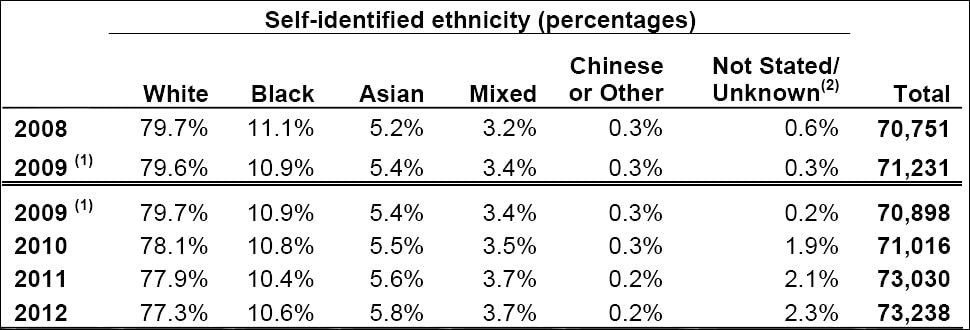Section 95
Section 95 of the Criminal Justice Act 1991 requires the Government to publish statistical data to assess whether any discrimination exists in the CJS. Last week the MoJ published its Statistics on Race and the Criminal Justice System 2012. It also published a set of excel spreadsheets with stats relating to:
- Victims
- Suspects
- Defendants
- Offenders
- Staff
This post presents the headline findings but it is well worth investing some time in reading the report and the associated tables.
Victims
Adults from Mixed, Black and Asian ethnic  groups were more at risk of being a victim of personal crime than their White counterparts. This has been true for the last four years. Adults from a Mixed ethnic group are at the highest risk.
groups were more at risk of being a victim of personal crime than their White counterparts. This has been true for the last four years. Adults from a Mixed ethnic group are at the highest risk.
Suspects
Black people aged 10 years and older were six times more likely than White people to be stopped and searched. Asian or Mixed race people were twice as likely to be stopped and searched compared to White people. The same inequalities can be seen in the arrest statistics where Black people are three times more likely and Mixed race people twice as likely as White or Asian people to be arrested.
Defendants
Again, Black people were less likely to receive an out of court disposal for an indictable offence and more likely to face proceedings in a Magistrates’ Court than all other ethnic groups. The most common sentence for White and Mixed race offenders was a community sentence while Black, Asian, Chinese or “Other” offenders were most likely to be sent to custody. The average length of custodial sentence for offenders sent to prison for indictable offences is longer for all BAME groups compared to White offenders. However, a higher proportion of White people are convicted of the offences for which they are charged than any other ethnic group.
Offenders
Black and Minority Ethnic group prisoners remain over-represented in the prison system. The table below shows the figures for the last five years. The table refers only to British national prisoners and ethnicity is identified by prisoners themselves:
For comparison, the 2011 Census found that 86% of the English and Welsh population was White.
Conclusion
The value of publishing these statistics annually is clear to see, even if the findings are predictably depressing.
Thanks to Mark Harvey for permission to use his image. You can see his criminal justice photos on his website.






